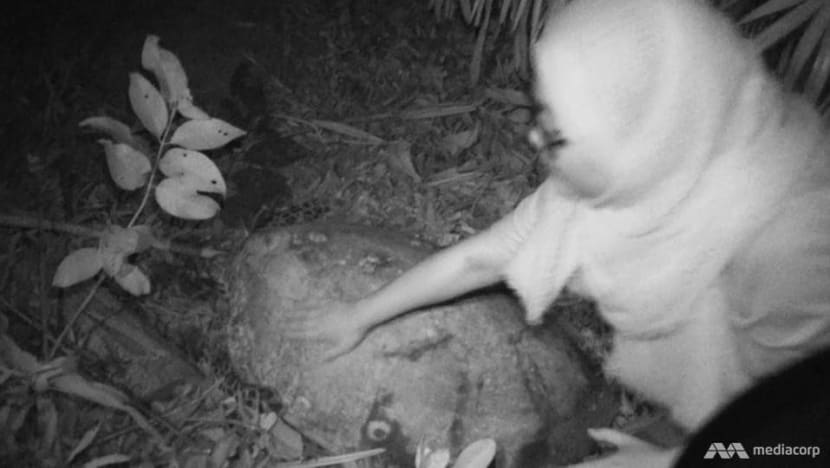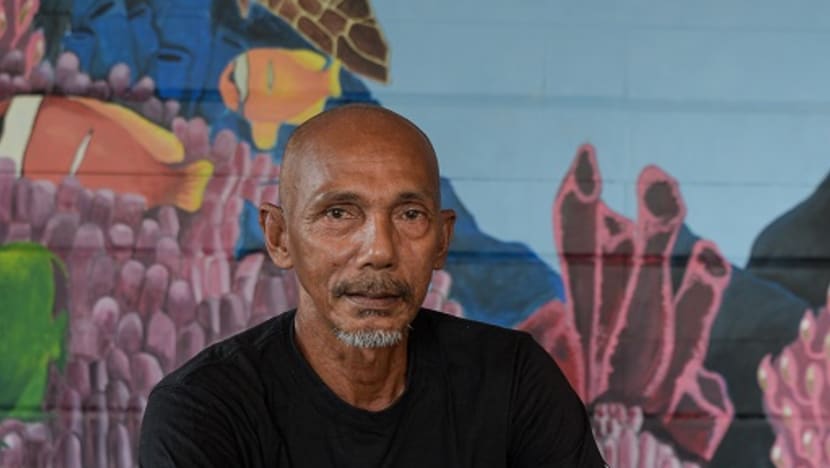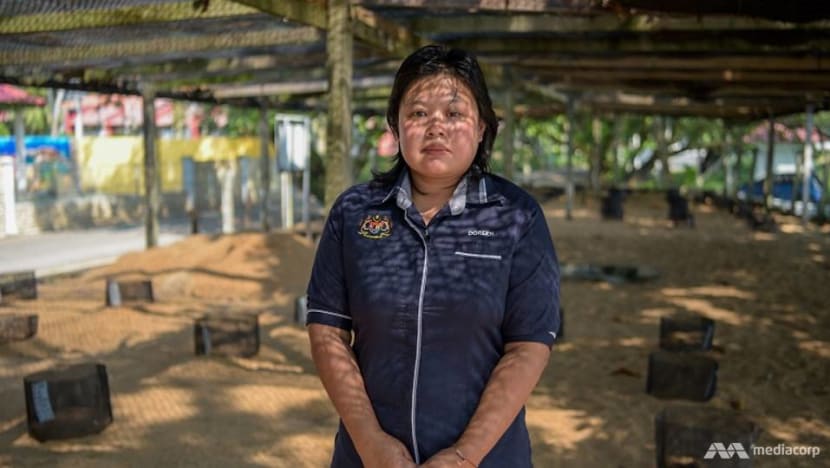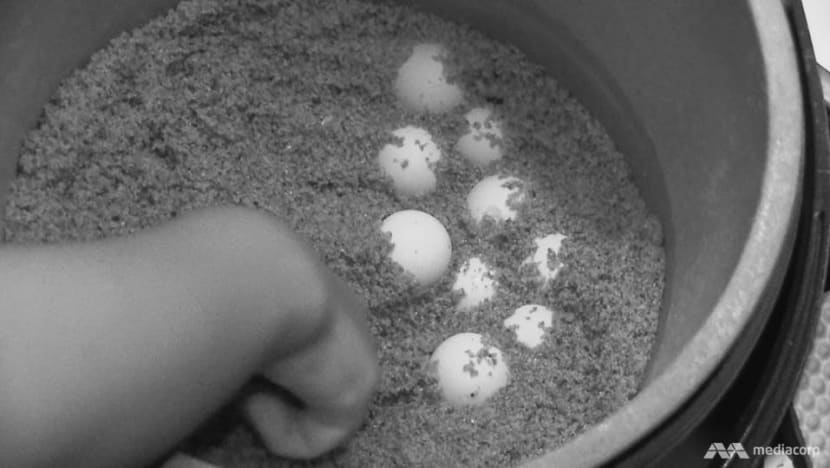Where to lay my eggs? Endangered hawksbill turtles face shrinking nesting grounds in Melaka
Tourist activities and land reclamation projects have made it hard for the endangered hawksbill turtle to nest along the coastline facing the Straits of Malacca.

The hawksbill turtle is classified as critically endangered, and the reclamation projects in Melaka are threatening its numbers. (Photo: Amir Yusof)
MELAKA: It was 9pm, and a female hawksbill turtle clambered clumsily onto a sandy beach 50km north of Melaka city centre.
It heaved its 75kg frame upslope, its flippers tensing with the effort. When it reached a dark spot, it wiggled its hind flippers in multiple attempts to dig little chambers deep enough to house more than 100 eggs.
But the shallow sand and wooden debris strewn across the beach made it impossible to make a nest. During the process, the turtle hit its head multiple times against a concrete wall at the top of the beach.
After about two hours of hard work, it gave up and fumbled back into the sea, without laying any eggs.
“She really wanted to lay her eggs, but because of the lights on the beach and the location, she could not,” said Ms Siti Norazliyana Ali, a World Wildlife Fund (WWF) official who leads turtle conservation efforts in the area, noting that the turtle made a total of seven attempts to make nests that night.
The area – called Tanjung Dahan – is one of 10 beaches in Melaka where hawksbill turtles would typically nest from April until September every year.
Hawksbill turtles, classified as critically endangered, make 500 to 600 nestings in Melaka every year, the highest concentration of landings in peninsular Malaysia.

However, the number of hawksbill turtle nestings have reduced in Melaka over recent years, as the state intensified its land reclamation efforts and its beaches have become increasingly popular for tourists, threatening the turtle’s existence in the region.
WWF and the Fisheries Department of Melaka are hoping that the state government would consider their proposal to create a sanctuary.
READ: Malaysia seizes 3,300 rare turtles in suspected trafficking case
HUMAN ACTIVITIES DETER TURTLES
The beaches in northern Melaka are frequented by Malaysian and foreign visitors, who drop by to picnic and indulge in sea sports.
Some also come after nightfall to catch fishes.
Mr Zainal Mahon, a local villager hired by WWF and the Fisheries Department of Melaka as a turtle guardian, told CNA that bright lights along the beach at Tanjung Dahan contributes to the decreasing turtle landings.

“The turtles are always disturbed by humans on the beach, some of them fishing at night. I have advised them not to use bright lights at night, informing them how it impacts turtles which nest in the area,” he said.
Beside tourism activities, land reclamation issues have also plagued northern Melaka, making it difficult for turtles to nest with ongoing construction work and shifting shorelines.
According to Ms Lau Min Min, WWF conservation manager for turtles in peninsular Malaysia, land reclamation has reduced landings in certain beaches by up to 70 per cent.

The Melaka department of fisheries cited how the the nestings at Pulau Upeh beach, for example, plunged from 110 in 2011 to 33 in 2018.
Land reclamation projects, which began in 2014, are also increasing, and this has a clear direct impact on the future of the hawksbill turtles, she added.
A fellow turtle guardian who operates in the area, Mr Tambi Shah, told CNA that the reclamation works have visibly eroded the beach.
“The landing areas for turtles, which were previously flat and nice, are now eroded and filled with fallen tree debris, making it difficult for turtles to land,” said Mr Tambi, who is stationed at Terendak Camp, a military base.

“So what I can do is to collect the wood and tree branches from the beach and burn them, so that they won't deter the turtles from nesting,” he added.
FROM TURTLE POACHERS TO TURTLE GUARDIANS
Protecting the turtles and creating a conducive environment for them are new endeavours for both Mr Zainal and Mr Tambi.
Previously, they were turtle egg poachers who would sneak around the beach after dark to collect turtle eggs to be sold in markets or for their own consumption.
Boiled and eaten with rice, turtle eggs are considered a delicacy among many coastal communities in Malaysia.
“The biggest positive outcome in converting from a poacher to a ranger is that we do not fight over eggs. And our income is certain, regardless if we manage to secure any turtle eggs,” Mr Tambi said.
With a salary of RM45 (US$11) per night, the turtle guardians protect the eggs, tag the mother turtles after they lag their eggs, and transfer the eggs to the hatchery.
READ: Turtle eggs are being sold openly in Sabah, and tourists are partly to blame
Their income comes to about RM600 a month during the turtle nesting season, which is more than what they could earn as poachers.
“It's enough to support my family,” said Mr Tambi.
WWF Malaysia’s Ms Lau highlighted that the guardians are trained as marine researchers and they play a huge role in helping hawksbill turtles breed.
“This is a transformation of the whole system, some of them were egg poachers but they are now turtle guardians. That’s what we are doing now in Melaka. That’s our forte,” she said.
HOPING FOR A WIN-WIN SOLUTION
To preserve the nesting areas for turtles, both WWF Malaysia and the Melaka Fisheries Department have suggested that the beach stretching 1km near Padang Kemunting be gazetted as a turtle sanctuary.
However, the state government has yet to respond to the proposal.

“Once it is gazetted, activities like fishing, camping, picnic activities and sea sports will not be allowed. I hope that the state government will support our cause,” said the fisheries department's deputy director Ms Doreen Wee.
“We expect the number of landings to reduce each year. We did mention this matter to the state government, and they do listen to us, but ultimately the reclamation works still continue. We cannot do anything about it. We can only give our comments,” she said.
WWF's Ms Lau outlined that one way to convince the government is to find a win-win outcome for all.
She said if the area is gazetted as a sanctuary, the turtles would be able to nest with less disturbance, and the government will benefit if the sanctuary becomes an eco-tourism attraction on turtle conservation.

“It’s about finding a compromise and a win-win solution.”
“We want to have a more cohesive programme which will benefit villagers and the state government. The beach can be an asset if it’s taken care of properly. We want to rehabilitate the beaches, and if it all comes into play, everybody will be happy,” she added.
Mr Tambi, the poacher-turned-guardian, has come to understand the importance of conservation.
He now finds himself advising villagers to stop consuming the eggs as the hawksbill turtle species is in danger of extinction.
“I always tell the villagers here that if you all just sit around and eat, eat and eat, if you find the eggs and eat, there will be no hatchlings released back to the sea.”

“And in 10 to 20 years, there will be no more turtles nesting here. The mother turtles will die naturally and the hatchlings would have been consumed by you.”
“The special thing about the hawksbill turtle is that it nests in Melaka, and this is a special thing for all Malaysia. We don’t want it to go away,” Mr Tambi said.














